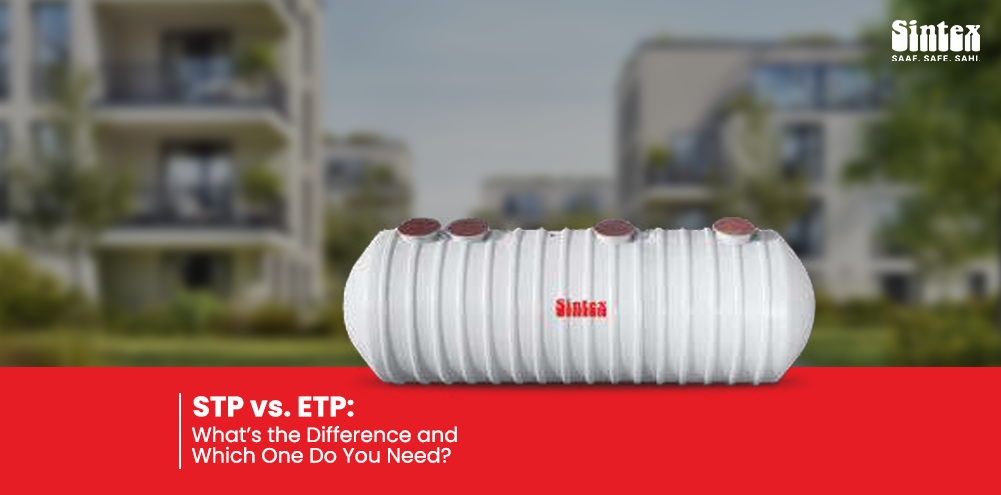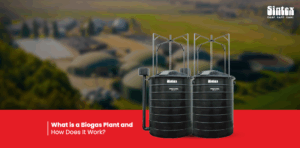STP vs. ETP: What’s the Difference and Which One Do You Need?
Share

Table of Contents
This blog consists of a simple yet detailed explanation of the difference between STPs (Sewage Treatment Plants) and ETPs (Effluent Treatment Plants) and how to choose the right one. STPs treat domestic wastewater like bathroom or kitchen discharge, making it reusable for gardening and cleaning. ETPs handle industrial effluents from factories, textiles, and pharmaceuticals, using complex chemical and biological processes to make water safe for discharge. A comparison table, real-world applications, and Sintex’s sustainable solutions—from FRP-based STPs to customizable ETPs—are highlighted.
Ever found yourself confused between STP and ETP while planning your project’s waste management system? Don’t panic; you’re not alone. A lot of people think that these two terms are synonymous, but they are not.
Whatever you do, whether you’re a facility manager, developer, or an environmentally astute homeowner, you can help yourself make better choices to know what sets them apart. Let’s get it straight and simple.
What Are STP and ETP?
STPs and ETPs are essentially waste treatment plants—but they treat a different type of waste.
- STP is short for Sewage Treatment Plant, which is used to treat domestic or sewage waste water treatment plant waste such as bathroom discharge, laundry water, and kitchen grey water.
- ETP is short for Effluent Treatment Plant, which treats industrial effluent. Examples include chemically contaminated water from factories, textiles, pharmaceuticals, etc.
Both are vital in checking environmental pollution, and they serve various uses.
What Makes Them Different?
There is the widest variation in the kind of waste they treat. STPs treat sewage, whereas ETPs are constructed for industrial effluents with toxins, heavy metals, or poisonous chemicals.
Let’s take an example: Consider that you are treating waste from a residential complex. You need a sewage water treatment plant. If you’re handling wastewater from a chemical plant or textile factory, you need an ETP.
STP: When and Where You Need It
We design our sewage treatment plants to work efficiently across residential and commercial areas. They process grey water, clean it up, and make it reusable for non-drinking purposes like gardening or floor cleaning.
Here’s what sets Sintex’s STPs apart:
- Built using FRP material for long life
- Works with the chop-whoop winding process for durable tanks
- Ranges from 10 KLD to 650 KLD capacity
- Supports close-to-source treatment
- Low maintenance and energy-efficient
- Suit apartments, hotels, office complexes, and public buildings
By putting in a sewage wastewater treatment plant, you are meeting local laws, conserving water, and being sustainable.
ETP: When and Where You Need It
Industrial setups have complex effluent needs. That’s where an Effluent Treatment Plant (ETP) steps in. These installations are put in place to treat high volumes of contaminants and render the water safe for discharge or recycling (subject to standards).
ETP is commonly used in:
- Manufacturing plants
- Textile and dye units
- Pharmaceutical industries
- Chemical factories
- Food and beverage industries
The treatment process is more complex than sewage treatment plants, involving extra steps such as neutralisation, chemical treatment, sedimentation, and biological treatment.
Key Differences at a Glance
| Feature | STP (Sewage Treatment Plant) | ETP (Effluent Treatment Plant) |
| Type of Waste Treated | Sewage, grey water | Industrial effluents, toxic waste |
| Treatment Process | Physical + Biological | Chemical + Physical + Biological |
| Application | Homes, offices, hotels, apartments | Factories, labs, industrial complexes |
| Output Water Usage | Gardening, flushing, cleaning | May need further treatment for reuse |
| Complexity | Moderate | High |
| Maintenance | Low | Medium to High |
Which One Is Right for You?
Still not sure what your project needs? Let’s simplify:
- Residential Society? → STP
- Factory or Plant? → ETP
- Hospital or Hotel? → Mostly STP, with possible ETP zones
- Educational Campus? → STP with a decentralised application
And remember, for homes or smaller establishments, septic tanks can still be a valid and cost-effective option. Our advanced septic tanks reduce BOD by up to 70%, don’t require electricity, and are available in sizes from 800 to 6000 litres.
Sustainable Solutions from Sintex
At Sintex, we don’t just sell systems, we deliver end-to-end sustainability. From our biogas plant that turns organic waste into energy, to septic tanks and sewage treatment plants, every product is engineered for efficient waste management.
Why choose us?
- Proven track record in waste-to-energy solutions
- Customizable capacity from homes to industries
- Long-lasting and durable materials
- Easier installation with low maintenance
- Environmentally friendly and according to national standards
We have a solution for your site if you are looking for a biogas plant, ETP, sewage water treatment plant, or septic tanks.
Final Thoughts
Knowledge of the difference between STP and ETP is not merely technical knowledge; it’s a wise decision for any person devoted to waste handling and the environment. At Sintex, we want to assist you in making the right decisions that are in your premises’ interest and the world’s.
So whether you’re planning a housing project, running a business, or building an eco-friendly factory, we’re here with the right solution, be it a biogas plant, an Effluent Treatment Plant, septic tanks or sewage treatment plants tailored for your needs.
FAQs
If you're managing a single home or a small setup, yes. However, for larger complexes, an STP is more effective and sustainable.
You’ll likely need an STP and an ETP system—each tackling a different type of waste.
No, but it’s perfect for gardening, flushing, and cleaning—saving you thousands of litres monthly.
